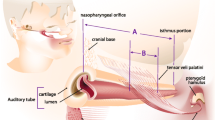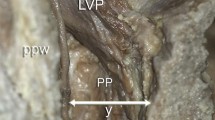Abstract
The tensor tympani muscle in addition to its well established functions decides the degree of eustachian tube opening by ‘tuning’ the tensor palati muscle. It helps cochlear protection as the ‘trigger zone’ for its reflex contraction in response to loud sound. Tensor tympani muscle is instrumental in curing mild degree of abnormally patulous eustachian tube (by functional tubal myoplasty) as well as moderate eustachian insufficiency (by physiological tympanostomy); whereas its bony semi-canal provides an avenue for by-passing the stenosed eustachian tube (tympano-nasopharyngeal shunt operation).
Four different parts of eustachian canal are dilated by the tensor palati muscle during the swallowing act. Tensor palati muscle is of surgical significance in the management of bilateral palatal palsy (by functional veloplasty) as well as in functional disorders of eustachian tube, e.g. physiological tubal stenosis (by functional tuboplasty); and abnormally patulous tube (by re-routing operation). The author recommends a new manoeuver (Physiologic autoinflation) of voluntary middle ear inflation as a therapeutic measure for cases of mild eustachian insufficiency and chronic serous otitis media, this manoeuver, being independent of both the phases of respiration, and the intrathoracic pressure, has potential for utilization in aviation medicine.
Similar content being viewed by others
References
Armstrong (1961): Airspace medicine, Chr. 11, pp. 162–74, Baltimore, Williams and Wilkins.
Bezold (1894): Quoted by Politzer, A., Diseases of Ear, Lea Brothers, Philadelphia.
Chunn, S. P. (1960): A comparison of the efficiency of Valsalva Manoeuver and the pharyngeal pressure test and the Feasibility of teaching both methods, ACAM Thesis, USAF, School of Airspace Medicine.
Cleland (1968–69): On question whether Eustachian tube is opened or closed in swallowing,J. Anato & Physiol. 3: 97–103.
Cleveland & Simbins, S. (1943): Functional anatomy of the Eustachian tube;Arch. Otolaryngol,33: 476–84.
Cooper, S. & Daniel, P. M. (1963: Muscle spindles in Man, Brain,86:563–86.
Drettner, B. and Ekvall, L. (1969): Tympano-maxillary shunt-a new method of middle ear ventilation; The Otolaryngologic Clinics of North America;90: 122–8.
Duvoisin, R. C., Kruse, F., Jr. and Saunder, S. D. (1962): Convulsion syncope induced by the Valsalva Maneuver in subjects exhibiting Low G. Tolerance;Aerospace, Medicine:33: 92–96.
Flisberg, K., Ingelstedts, S., and Ortegren, V., (1963): Acta Otolaryngologica supplement, 182, page 43.
Gray’s Anatomy, 34th ed. (1967): pp. 1324–5. Longmans, Green and Co., Ltd., Harlow.
Henle (1876): Quoted by Rich, A. R.
House, W. F. and Miles, J. (1969): Middle fossa Eustachian Tuboplasty:Laryngoscope,79: 1765–82.
Juan, B. Gonzalez and Arnold, E. Aronson (1970): Palatal lift prosthesis for treatment of Anatomic and Neurological Palatopharyngeal insufficiency; Cleft palate J.,7: 91.
Lapidot, A. and Kapila, B., (1967): Early clinical experience in reconstruction of a substitute Eustachian tube;Arch. Otolaryngol.,86: 490–6.
Lawrence, M. (1962): The double innervations of the ‘tensor tympani’.Ann. Otol. Rhin., & Laryng.,71: 705.
Lupin, A. J. (1969): The relationship of tensor tympani and tensor palati muscles;Arch. Otolaryngol.,78: 792.
Macbeth, R. G. (1960): Some thoughts on the Eustachian tube;Proc. Roy.Soc. Med.,53: 151–61.
Miller, G. F. (1965): Eustachian tube function in Normal and Diseased Ears;Arch. Otolaryng.,81: 41–8.
Misurya, V. K. (unpublished): New dimensions of physiology of tympanic muscles.
Misurya, V. K., (in press): Tensor tympani—a ‘tuner’ of tensor palati muscle; Acta Otolaryng.
Misurya, V. K. (in press): Physiological Tympanostomy;J. Laryng.
Misurya, V. K. (in press) : Functional Tubal Myoplasty; Arch. Otolaryng.
Misurya, V. K. (1975): Tympano-nasopbaryngeal Shunt operation—a new method of middle-ear ventilation;J. Laryng. 34: 189–97.
Misurya, V. K. (in press): Functional anatomy of tensor palati and Levator palati muscle;Arch. Otolaryng.
Misurya, V. K. (1974): Surgical treatment of abnormally patulous Eustachian tube;J. Laryng. 38: 877–83.
Misurya, V. K. (in press): Functional Eustachian tuboplasty;Arch. Otolaryng.
Misurya, V. K. (in press) : Functional Veloplasty;Arch. Otolaryng.
Misurya, V. K. (in press) : Physiologic Eustachian Inflation;Arch. Otolaryng.
Nordhoff (1950): Quoted by Frenzel, H.: Otolaryngology In German Aviation Medicine World War II; 2: 10-A: 977–94, Washington, U. S. Government Printing Office, 1950.
Perlman, H. B. (1939): The Eustachian tube, abnormal patency and normal physiological state;Arch. Otolaryng,30: 212–38.
Perlman, H. B. (1951): Mouth of Eustachian tube;Ann. Otol. Rhin & Laryng.,53: 353–69.
Perlman, H. B., (1960):Arch. Otolaryng.,32: 201.
Pitman, L. K. (1929): The open Eustachian tube;Arch. Otolaryng.,9: 494–500.
Politzer, A. (1883): Diseases of Ear; Lea Brothers, Philadelphia.
Poppen, J. R. (1941): The ear in flying;Trans. Amer. Otol. Soc.,31: 282–91.
Rich, A. R. (1920): Physiology of Eustachian tube and its related muscles;Bull. Johns Hopkins Hosp.,31: 206.
Shambaugh, G. E. Jr. (1938): Continuously open Eustachian Tube;Arch. Otolaryng.,27: 420.
Siirala, V. (1964): Archives of Otolaryng.,80: 287–96.
Stroud, M. H. (1974): Patulous Eustachian tube syndrome;Arch. Otolaryng.,99: 419–21.
Toynbee (1853): On the muscles which open the Eustachian tube,Proc. Royal Soc.,53: 151–61.
Valsalva (1704): Quoted by Stevenson, R. S. and Guthrie: A History of Otolaryngology; Edinburgh, E. and S. Livingstone, 1949.
Von Kostanecki, K. (1887): Quoted by Franz Altman (1951). Malfunction of the Eustachian tube, middle-ear and its appendages;Arch. Otolaryng.,40: 241–66.
Wullstein, H. (1963): Eustachian tube in tympanoplasty;Arch. Otolaryng.,71: 408.
Zollner, F. (1936): Quoted by Perlman, H. B. (1939).
Zollner, F. (1963): Therapy of Eustachian tube;Arch. Otolaryng.,78: 394.
Author information
Authors and Affiliations
Additional information
Dr. R. A. F. Cooper Award Paper read at the 28th Annual Conference of the Association Otolaryngologists of India held in Calcutta January 1976.
Rights and permissions
About this article
Cite this article
Misurya, V.K. Role of tensor (palati and tympani) muscle-complex in health and diseases. Indian J Otolaryngol 28, 67–72 (1976). https://doi.org/10.1007/BF02990581
Issue Date:
DOI: https://doi.org/10.1007/BF02990581




